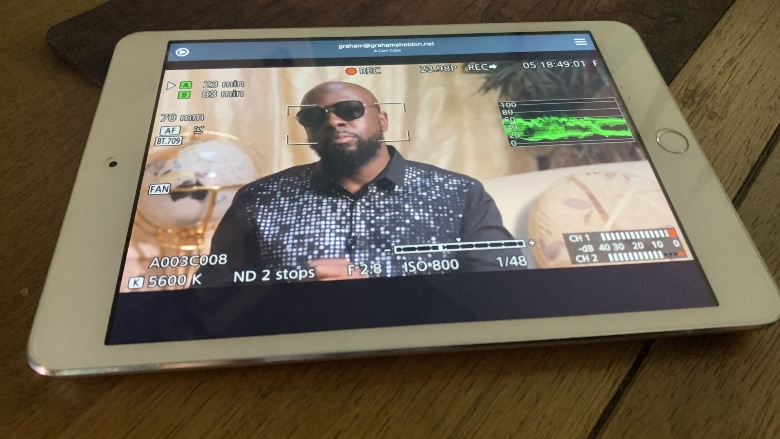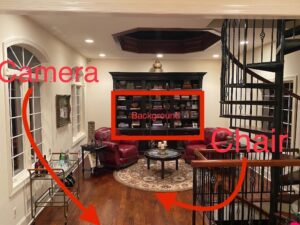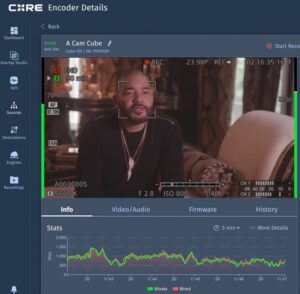
COVID-19 pandemic protocols have forced filmmakers to take new precautions towards doing their craft, and that’s equally true for documentary filmmakers. When Cinematographer Graham Sheldon (The Island) was called upon to provide his skills for the Remote Production on showrunner Johnny Fountain‘s Behind Every Man docuseries, he had to find new ways of achieving his quality work using talent not quite qualified to operate cameras.
Behind Every Man is a ten-episode series currently streaming on OWN that focuses its lens on the strong black women behind famous men, including Tammy and Kirk Franklin; singer-songwriter Ne-Yo and his wife Crystal Smith; Wyclef Jean and Marie Claudinette, Usher and his mother Jonnetta Patton, and many more. The series is hosted by Melody Holt, and most of the episodes are shot within the homes of those featured, and just using computer webcams wouldn’t be sufficient.
“There could be no crew members on the scene. All equipment had to be set up by the talent and their COVID-19 pod in their house,” Sheldon said about this challenge, “We had to make sure it was easy for non-camera pros to set up, right out of the box.”
Sheldon chose the Canon C300 MK II as his camera of choice due to quality of facial auto focus along with the Sigma 24-70mm lens for its autofocus, shooting in UHD to have control over composition. The cameras sent to talent included a large SanDisk Cfast 256 GB, set to “auto.”
 Sheldon’s next step was critical in order to be able to allow real-time streaming and monitoring, and that involved putting together a Teradek system to ensure Sheldon could work with the talent once they received their equipment packages to insure the best-looking shots.
Sheldon’s next step was critical in order to be able to allow real-time streaming and monitoring, and that involved putting together a Teradek system to ensure Sheldon could work with the talent once they received their equipment packages to insure the best-looking shots.
“I needed a level of confidence that it would work in real production scenarios with people who were particular. I knew that the Teradek team would have it figured out,” Sheldon reasoned.
Creative Solutions‘ Director of Marketing Andrew Ng, spoke about putting together the right package for filming the 12 episodes in April and May 2020. “At the time Graham’s production was unique because there wouldn’t be a professional film crew operating the equipment with the talent. We turned to Cube 755 as our most versatile solution to provide solid reliability, premium quality HEVC encoding, and encrypted security. The biggest challenge wasn’t the technology requirement but ensuring the level of confidence expected by producers familiar with Teradek’s zero-delay on-set solutions. After reviewing the production workflow variables, we were able to deploy a virtual workflow that could be scaled as needed.”
This Cube was pre-configured to the corresponding cameras, so that it would just need to be plugged into power when the two arrived at each location. 5 of these identical equipment packages were prepped and sent to different locations in order to shoot multiple episodes at the same time. Remote video was accessed via iPads, Apple TVs, and web browsers using Teradek Core, the cloud-based streaming management platform. This allowed Sheldon to direct photography and also provide the rest of the production with a real-time virtual video village experience.
“We color-coded all the buttons and came up with a laminated card so if they were visual it would make sense. If they were audial, they would listen to us,” Sheldon said, using Production Manager Nicki Marshall to test the kit to make sure it would all work properly.

Sheldon connected with the interview subjects in advance to prep them for the gear arriving, getting pictures and videos of their living spaces so they could plan the best location and lighting set-up. “We looked for controllable light and depth in the room,” he explains. “They couldn’t be against the sun and we needed good depth of field—no flat-looking announcer shots. We also walked them through Internet speed checks to determine if we needed to pre-prep Teradek Node modems to assure reliable cellular connectivity, or if we could get set for Wi-Fi.”
Even so, the stars had to get in the right headspace for the level of work they would have when the 6 Pelican cases arrived on their doorstep. That’s when Graham and his AC, Melissa Kirchhoff, would pop on Zoom and run them through setting up the camera packages. “Sometimes family members in their pod would help—a daughter, sister, uncle, assistant. For the most part no one had production experience,” Sheldon said about the enthusiasm the subjects had towards the challenge. “Everyone from an 80-year-old to a 15-year-old was able to do it.”
It would take anywhere between 30 and 90 minutes to set up the equipment, and Sheldon was able to monitor the interviews from his office in Southern California using three devices to monitor using Zoom, Slack and the “user friendly” CORE TV. The production team stakeholders were able to view the camera stream on their own devices, as well.
“Once everything was lit, we were mostly on autopilot from the DP perspective. My AC Melissa Kirchhoff would cover for me when I bounced between different interviews,” Sheldon added. “The talent really got into participating in the production so it all worked out. Its amazing what you can do if you are willing to embrace the craziness of 2020.”
Sheldon will be discussing the emerging technology and tactics involved with virtual production in the live session, CS Presents Virtual Production: The New Wave of Digital Collaboration, this Thursday, January 7, at 10AM PST. You can register to take part in this free live chat here.
All photos provided by Graham Sheldon. (Click on photos for larger versions.)





